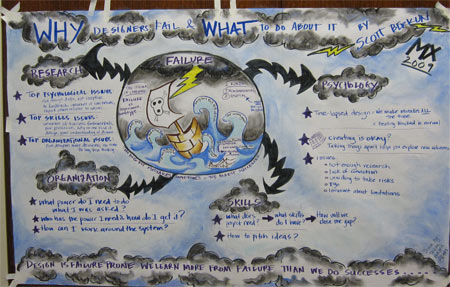How to visually capture a talk or presentation
One of my favorite things at Adaptive Path’s MX event this week was how they had designers assigned to make large drawings based on the current talk, as the talk was happening. It was real time art/design/creation – super cool.
Here’s Teresa Brazen’s drawing of my talk, Why designers fail:
The cool thing is that as I watched other people’s talks during the day, if ever I got bored I could watch their drawing being made in real time and see what the designer was calling out as key points, or even how they interpreted what was being said. I found it was a great, non distracting way to add to what was being presented. I really hope more events do this kind of thing.


These are great mind maps!
What excellent feedback! The presenter would really have to be well organized in developing their ideas to guide the artist’s rendering of it. If I knew an artist, I’d engage them before my presentation to make sure my message was getting across in the way that I intended.
Scott, does that sketch reflect what you hoped it would? I’m curious, too, about the pirate ship — does that image/metaphor come from your talk, or from the designer?
Hi, Scott, Kate from Adaptive Path here.
This is a great post, and thanks for highlighting one of the activities that we think makes MX a very special event.
I wanted to shed a bit more light on the method, where it comes from and how you can do it, too.
The technique is called graphic recording, and it was created and pioneered by a company called the Grove Consultants (see link below.) The Grove has books and videos you can get to learn the method, and it’s very accessible for anyone who is interested in the approach.
A clarification: The AP folks creating the maps were not all trained designers or visual artists (‘tho we are lucky that Teresa of said pirate map is!)
The key to the technique is listening, capturing the key information, and arranging it in a way that summarizes the content, the relationships inherent in the information and the spirit of the conversation. Anyone who can listen and write can do this.
AP Project Manager Todd Elliott organized the whole shebang from our end. We got in practice by listening to the TED videos, which is a great way to do this on your own. Another option is podcasts (radio interviews are perfect…’This American Life’ is a challenge to work up to!)
An extension of this method is using it as a facilitation tool for group conversations, which is a powerful way to elicit discussion, buy-in and participation…and you have a visual artifact to evidence the conversation.
I’d encourage anyone who is interested in this approach to look into it further and try it on your own. Not only is it fun, it’s a powerful way to create a concrete and visually resonant map that aids memory and extends the original experience.
Related Links:
* Graphic Recording at MX 2009
* The Grove Consultants
* VisualPractitioner.org
* Center for Graphic Facilitation
Teresa looked at my slides beforehand, but I was more than happy to let her interpret the talk however she wanted. What better as a feedback for me as a speaker to see what she chose to capture and what she didn’t?
I love it just because it was interesting in its own right – forget the talk, she made something interesting all its own.